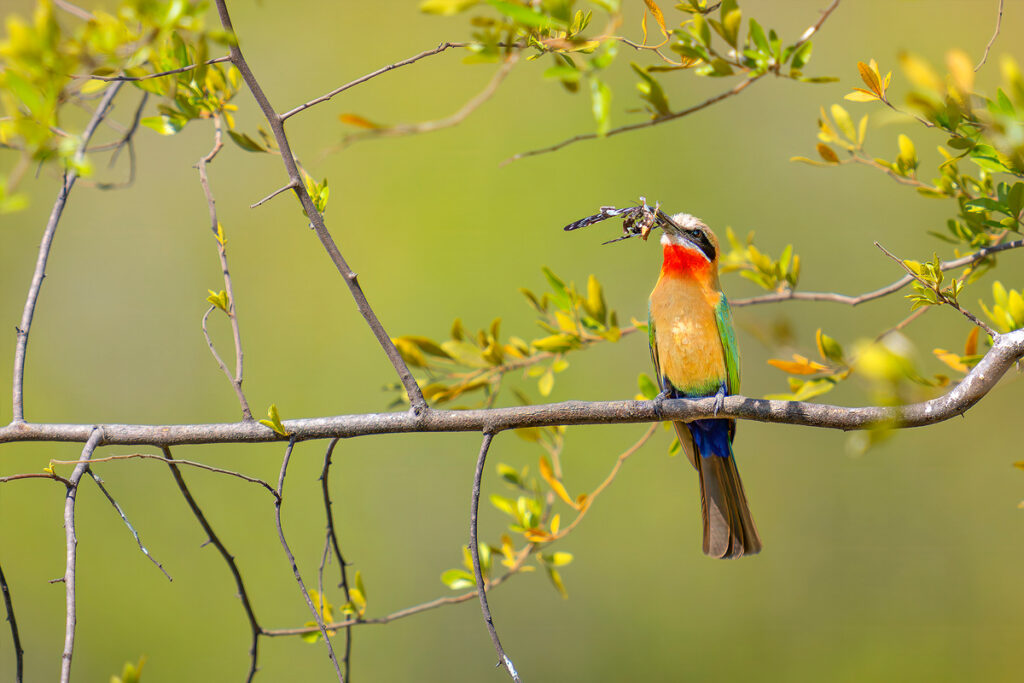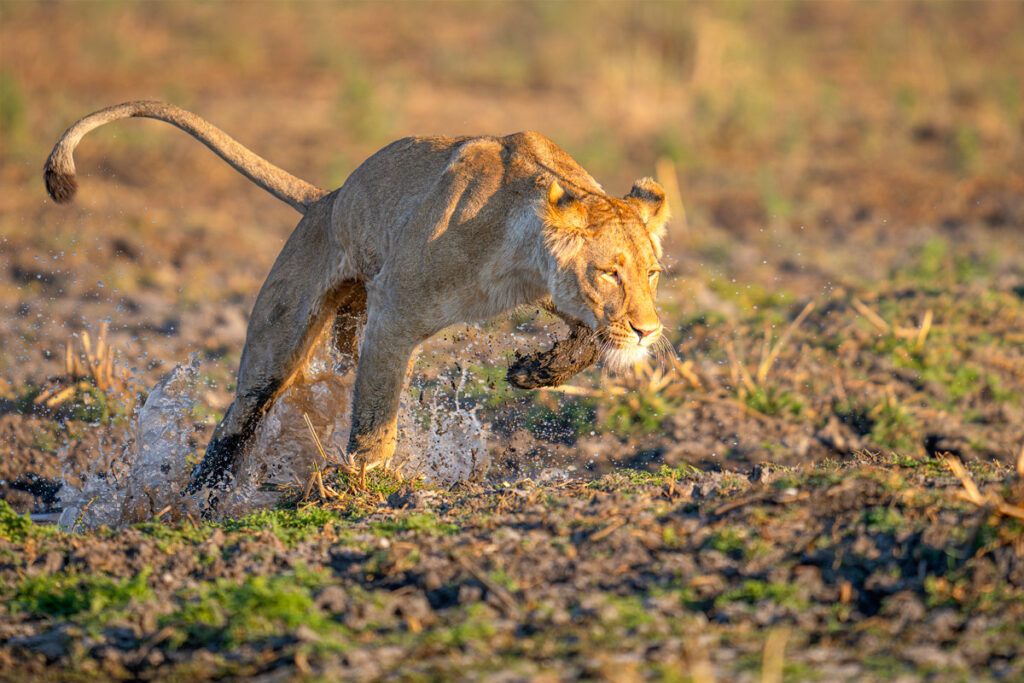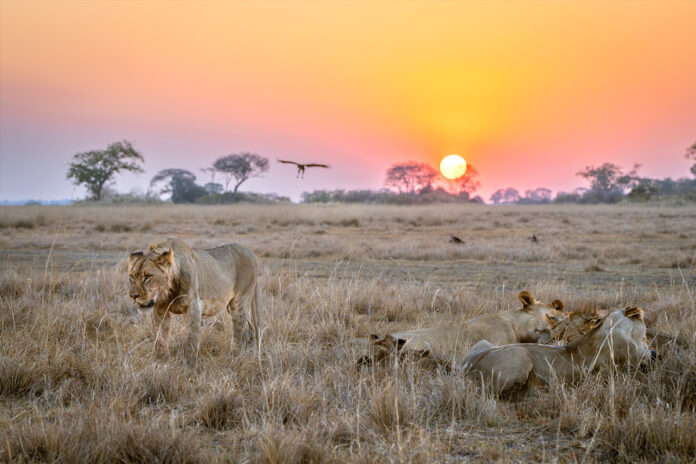Although Zambia has offered wildlife-viewing safaris (as opposed to hunting expeditions) since the 1950s, the country remains something of an insider’s tip among Africa travellers. There are no souvenir shops at the entrances to the national parks here – instead, visitors find pristine wilderness and an astonishing density of big cats: lions and leopards are almost guaranteed sightings!
“South Africa mainly attracts first-time safari-goers, Namibia is perfect for campers and self-drivers, but Zambia is an undiscovered pearl – a destination for true connoisseurs,” laughs the sunburnt Canadian in his faded safari shirt as he takes his seat beside me in the single-engine Cessna Caravan. There are only three passengers on board when the propeller plane takes off, right on the dot. Even in the departure hall of Lusaka’s domestic terminal there had been no sign of tourist crowds. A good omen, I hope, for solitude and untouched nature in the country’s national parks.
Elephants at Dusk
Barely half an hour later we are circling above our destination – a bush airstrip carved into the wilderness on the banks of the Zambezi. Grinning, the pilot points downwards, signalling us to be patient. Through the scratched cockpit window we spot a mother elephant with her calf, startled by the drone of the engine, dashing across the runway and obliging us to take an impromptu victory lap in the skies. A charming delay!

We land, I bid farewell to the Canadian – who is warmly greeted by two guides – and climb into the sand-coloured Toyota Land Cruiser already waiting for my companion and me. We waste no time and our safari begins at once, though the day is drawing to a close. A pod of hippos bathed in the golden light of sunset and a bull elephant by the river at dusk provide our first picture-book impressions of Africa.
It fits well, for Lower Zambezi National Park is famed for its large elephant herds. We never tire of watching the gentle giants, even the following day. Yet there is much more to discover: brightly coloured bee-eaters snatching insects from the air with elegance, bushbucks, kudus and hundreds of ever-alert impalas, ready to flee at the slightest hint of danger. And, of course, the big cats every safari-goer dreams of seeing – unlike the antelopes, whose greatest wish is never to encounter them.

Spellbound by Lions
The powerful lion raises his head, clearly displeased by the unwanted observers who have come too close to him and his mate, disturbing their courtship ritual. Yellow teeth, sharp as knives, flash in the fading light – a promise of deadly force. A deep growl underscores the unmistakable threat. The piercing gaze of his amber eyes shatters any illusion of safety afforded by the safari vehicle; I feel small and vulnerable, acutely aware that in the face of this predator’s raw power, we would stand no chance. Our guide evidently shares this assessment and we cautiously retreat.

An unusual reaction, for normally the great cats are unfazed by the rattling metal boxes around them. In the remote wilderness of the Busanga Plains in Kafue National Park a few days later, we are amazed when a whole group of lionesses with their young cubs – only a few months old – seek shade beneath our vehicle, entirely unbothered, unhurried and unafraid, as if we were simply part of the landscape.
After nightfall, however, the lions become active and set out to hunt – and our guide Idos knows their habits inside out. He leads us directly to their favourite hunting grounds, where we watch a pride stealthily closing in on some red lechwes. The lions appear languid, disinterested – but this is part of the tactic. Every step is measured, every pause serves to shorten the distance to their prey without arousing suspicion. My heart races, secretly rooting for the lions. But the antelopes sense the impending danger and, in a split second, bolt – the element of surprise gone, tonight’s hunt has failed.
Nocturnal Hunters
While the Busanga Plains offer perfect conditions for lion sightings, South Luangwa National Park in eastern Zambia impresses with a remarkable leopard population. “There – a leopard!” our guide exclaims triumphantly, pointing to the crown of a tree. Yet our untrained eyes struggle to distinguish the spotted paws peeking out from a forked branch from the surrounding foliage. Hundreds of these elusive cats live here, but sightings are by no means guaranteed – they are masters of disguise.

We leave the animal, lounging in what cannot possibly be a comfortable position among the branches, but carefully note the spot. For unlike many other African parks, here one has the unique opportunity to search for the nocturnal hunters after sunset. Sure enough, a few hours later, we find the leopard again in a neighbouring tree, this time with a sizeable kill. A moment of fortune – not only for the elegant predator, feasting contentedly on the impala buck, but also for us. Another highlight of the journey!
In the following days, we encounter two more leopards, completing our safari. The Canadian had been right: precisely because many tourists overlook Zambia (there are no rhinos here, hence no chance to tick off the full Big Five), the relatively low visitor numbers create an intimate atmosphere, preserving a wild paradise for safari lovers – a place where the intense encounters with mighty big cats will remain etched in my memory.

Don’t Miss
Most lodges offer morning and afternoon safaris as standard. On request (and sometimes at extra cost), it is possible to spend an entire day in the parks from sunrise to sunset, picnic lunch included. For me, this is an absolute must – discoveries without the pressure of time!
Best Avoided
Alongside the big game, there are plenty of small nuisances in the national parks. Chief among them are tsetse flies, constant companions on safari. Shorts are best left at home – instead wear lightweight, long-sleeved clothing to cover as much skin as possible. Light colours are advisable, as the flies are especially attracted to dark tones.
Insider Tip
Those who wish to experience something of Zambia’s rich culture alongside its wildlife should make a detour from South Luangwa National Park to Katete, home to the Tikondane Community Centre. In one of the villages participating in the project, we witnessed an energetic Nyau performance. Advance registration – a few weeks ahead – is required. tikondane.org
Text & photos: Laurent Nilles

